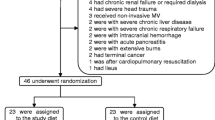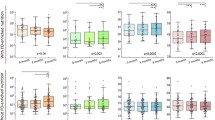Abstract
Background
Although the anti-inflammatory effects of immunomodulating diets (IMDs) have recently attracted attention, the efficacy of enteral feeding of such diets after radical surgery remains controversial. Thus, we conducted a new prospective, randomized controlled study to elucidate any beneficial effect of an IMD containing eicosapentaenoic acid (EPA) and γ-linolenic acid (GLA) in patients undergoing radical esophagectomy for thoracic esophageal cancer.
Methods
From November 2009 to July 2011, 87 consecutive patients were randomized to receive either an IMD enriched with EPA, GLA, and antioxidants (n = 42) or a standard isocaloric, isonitrogenous diet (control group, n = 45) after esophagectomy with radical lymphadenectomy. The primary outcome measure was changes in the oxygenation status (PaO2/FIO2 ratio), and the secondary outcome measures were body composition, inflammation-related factors, coagulation markers, cholesterol concentrations, and major clinical outcomes.
Results
Oxygenation was significantly better on postoperative days (PODs) 4, 6, and 8 in the IMD than control group (366.5 ± 63.3 vs. 317.3 ± 58.8, P = 0.001; 361.5 ± 52.6 vs. 314.0 ± 53.2, P < 0.001; 365.4 ± 71.2 vs. 315.2 ± 56.9, P = 0.001, respectively). Changes in the ratio of body weight on PODs 14 and 21 and lean body weight on POD 21 were significantly greater in the IMD than control group. No significant differences were observed in other measures.
Conclusions
An enteral IMD enriched with EPA and GLA improved oxygenation and maintained the body composition of patients undergoing radical esophagectomy, indicating the potential efficacy of such a diet after esophagectomy.





Similar content being viewed by others
References
Kooguchi K, Kobayashi A, Kitamura Y et al (2002) Elevated expression of inducible nitric oxide synthase and inflammatory cytokines in the alveolar macrophages after esophagectomy. Crit Care Med 30:71–76
Lin E, Calvano SE, Lowry SF (2000) Inflammatory cytokines and cell response in surgery. Surgery 127:117–126
Reid PT, Donnelly SC, MacGregor IR et al (2000) Pulmonary endothelial permeability and circulating neutrophil-endothelial markers in patients undergoing esophagogastrectomy. Crit Care Med 28:3161–3165
Wright CD, Kucharczuk JC, O’Brien SM et al (2009) Predictors of major morbidity and mortality after esophagectomy for esophageal cancer: a society of thoracic surgeons general thoracic surgery database risk adjustment model. J Thorac Cardiovasc Surg 137:587–596
Fujita T, Daiko H, Nishimura M (2012) Early enteral nutrition reduces the rate of life-threatening complications after thoracic esophagectomy in patients with esophageal cancer. Eur Surg Res 48:79–84
Alexander JW (1998) Immunonutrition: the role of omega-3 fatty acids. Nutrition 14:627–633
Grimble RF (1998) Nutritional modulation of cytokine biology. Nutrition 14:634–640
Murray MJ, Kumar M, Gregory TJ et al (1995) Select dietary fatty acids attenuate cardiopulmonary dysfunction during acute lung injury in pigs. Am J Physiol 269:H2090–H2099
Mancuso P, Whelan J, DeMichele SJ et al (1997) Dietary fish oil and fish and borage oil suppress intrapulmonary proinflammatory eicosanoid biosynthesis and attenuate pulmonary neutrophil accumulation in endotoxic rats. Crit Care Med 25:1198–1206
Palombo JD, DeMichele SJ, Boyce PJ et al (1999) Effect of short-term enteral feeding with eicosapentaenoic and gamma-linolenic acids on alveolar macrophage eicosanoid synthesis and bactericidal function in rats. Crit Care Med 27:1908–1915
Gadek JE, DeMichele SJ, Karlstad MD et al (1999) Effect of enteral feeding with eicosapentaenoic acid, gamma-linolenic acid, and antioxidants in patients with acute respiratory distress syndrome. Enteral Nutrition in ARDS Study Group. Crit Care Med 27:1409–1420
Pacht ER, DeMichele SJ, Nelson JL et al (2003) Enteral nutrition with eicosapentaenoic acid, gamma-linolenic acid, and antioxidants reduces alveolar inflammatory mediators and protein influx in patients with acute respiratory distress syndrome. Crit Care Med 31:491–500
Singer P, Theilla M, Fisher H et al (2006) Benefit of an enteral diet enriched with eicosapentaenoic acid and gamma-linolenic acid in ventilated patients with acute lung injury. Crit Care Med 34:1033–1038
Pontes-Arruda A, Aragao AM, Albuquerque JD (2006) Effects of enteral feeding with eicosapentaenoic acid, gamma-linolenic acid, and antioxidants in mechanically ventilated patients with severe sepsis and septic shock. Crit Care Med 34:2325–2333
Pontes-Arruda A, Martins LF, de Lima SM et al (2011) Enteral nutrition with eicosapentaenoic acid, gamma-linolenic acid and antioxidants in the early treatment of sepsis: results from a multicenter, prospective, randomized, double-blinded, controlled study: the INTERSEPT study. Crit Care 15:R144
Stapleton RD, Martin TR, Weiss NS et al (2011) A phase II randomized placebo-controlled trial of omega-3 fatty acids for the treatment of acute lung injury. Crit Care Med 39:1655–1662
Rice TW, Wheeler AP, Thompson BT et al (2011) Enteral omega-3 fatty acid, gamma-linolenic acid, and antioxidant supplementation in acute lung injury. JAMA 306:1574–1581
Grau-Carmona T, Moran-Garcia V, Garcia-de-Lorenzo A et al (2011) Effect of an enteral diet enriched with eicosapentaenoic acid, gamma-linolenic acid and anti-oxidants on the outcome of mechanically ventilated, critically ill, septic patients. Clin Nutr 30:578–584
Ryan AM, Reynolds JV, Healy L et al (2009) Enteral nutrition enriched with eicosapentaenoic acid (EPA) preserves lean body mass following esophageal cancer surgery: results of a double-blinded randomized controlled trial. Ann Surg 249:355–363
Sultan J, Griffin SM, Di Franco F et al (2012) Randomized clinical trial of omega-3 fatty acid-supplemented enteral nutrition versus standard enteral nutrition in patients undergoing oesophagogastric cancer surgery. Br J Surg 99:346–355
Sakurai Y, Masui T, Yoshida I et al (2007) Randomized clinical trial of the effects of perioperative use of immune-enhancing enteral formula on metabolic and immunological status in patients undergoing esophagectomy. World J Surg 31:2150–2157 discussion 2158-2159
Takeuchi H, Ikeuchi S, Kawaguchi Y et al (2007) Clinical significance of perioperative immunonutrition for patients with esophageal cancer. World J Surg 31:2160–2167
Osugi H, Takemura M, Lee S et al (2005) Thoracoscopic esophagectomy for intrathoracic esophageal cancer. Ann Thorac Cardiovasc Surg 11:221–227
Desborough JP (2000) The stress response to trauma and surgery. Br J Anaesth 85:109–117
Staal-van den Brekel AJ, Dentener MA, Schols AM et al (1995) Increased resting energy expenditure and weight loss are related to a systemic inflammatory response in lung cancer patients. J Clin Oncol 13:2600–2605
Falconer JS, Fearon KC, Plester CE et al (1994) Cytokines, the acute-phase response, and resting energy expenditure in cachectic patients with pancreatic cancer. Ann Surg 219:325–331
Kotler DP (2000) Cachexia. Ann Intern Med 133:622–634
Tracey KJ, Morgello S, Koplin B et al (1990) Metabolic effects of cachectin/tumor necrosis factor are modified by site of production. Cachectin/tumor necrosis factor-secreting tumor in skeletal muscle induces chronic cachexia, while implantation in brain induces predominantly acute anorexia. J Clin Invest 86:2014–2024
Price SA, Tisdale MJ (1998) Mechanism of inhibition of a tumor lipid-mobilizing factor by eicosapentaenoic acid. Cancer Res 58:4827–4831
Wigmore SJ, Fearon KC, Maingay JP et al (1997) Down-regulation of the acute-phase response in patients with pancreatic cancer cachexia receiving oral eicosapentaenoic acid is mediated via suppression of interleukin-6. Clin Sci Lond 92:215–221
Lee HN, Surh YJ (2012) Therapeutic potential of resolvins in the prevention and treatment of inflammatory disorders. Biochem Pharmacol 84:1340–1350
Xu ZZ, Zhang L, Liu T et al (2010) Resolvins RvE1 and RvD1 attenuate inflammatory pain via central and peripheral actions. Nat Med 16:592–597
Arita M, Yoshida M, Hong S et al (2005) Resolvin E1, an endogenous lipid mediator derived from omega-3 eicosapentaenoic acid, protects against 2,4,6-trinitrobenzene sulfonic acid-induced colitis. Proc Natl Acad Sci U S A 102:7671–7676
Li C, Bo L, Liu W et al (2015) Enteral immunomodulatory diet (omega-3 fatty acid, gamma-linolenic acid and antioxidant supplementation) for acute lung injury and acute respiratory distress syndrome: an updated systematic review and meta-analysis. Nutrients 7:5572–5585
Santacruz CA, Orbegozo D, Vincent JL et al (2015) Modulation of dietary lipid composition during acute respiratory distress syndrome: systematic review and meta-analysis. J Parenter Enteral Nutr 39:837–846
Zhu D, Zhang Y, Li S et al (2014) Enteral omega-3 fatty acid supplementation in adult patients with acute respiratory distress syndrome: a systematic review of randomized controlled trials with meta-analysis and trial sequential analysis. Intensive Care Med 40:504–512
Di Stasi D, Bernasconi R, Marchioli R et al (2004) Early modifications of fatty acid composition in plasma phospholipids, platelets and mononucleates of healthy volunteers after low doses of n-3 polyunsaturated fatty acids. Eur J Clin Pharmacol 60:183–190
Osugi H, Takemura M, Higashino M et al (2003) A comparison of video-assisted thoracoscopic oesophagectomy and radical lymph node dissection for squamous cell cancer of the oesophagus with open operation. Br J Surg 90:108–113
Acknowledgements
This trial was supported by Grants-in-Aid for scientific research from the Japan Society for Parenteral and Enteral Nutrition. The authors appreciate the Second Surgical Department of the Osaka City University Hospital for their cooperation during the study. Particularly, they thank K. Mori, M. Okawa, Y. Niwa, R. Hashiba, K. Gyobu, and S. Shinjo for help with patient recruitment and data collection and E. Edagawa for patient randomization. They also thank Y. Nakamura and G. Oka for their excellent work in the assessment and analysis of body composition.
Funding
The authors were personally salaried by their institutions during the period of writing. The funding source had no role in the study design, data collection, data interpretation, data analysis, or writing of the report.
Author information
Authors and Affiliations
Corresponding author
Ethics declarations
Conflict of interest
The authors declare that they have no conflicts of interest.
Additional information
UMIN clinical trials registry—UMIN000002659.
Electronic supplementary material
Below is the link to the electronic supplementary material.
Rights and permissions
About this article
Cite this article
Matsuda, Y., Habu, D., Lee, S. et al. Enteral Diet Enriched with ω-3 Fatty Acid Improves Oxygenation After Thoracic Esophagectomy for Cancer: A Randomized Controlled Trial. World J Surg 41, 1584–1594 (2017). https://doi.org/10.1007/s00268-017-3893-y
Published:
Issue Date:
DOI: https://doi.org/10.1007/s00268-017-3893-y




